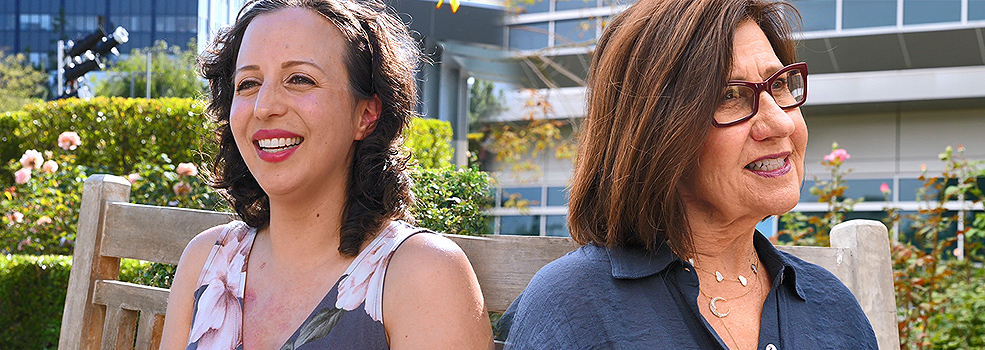
Why Mastectomy or Breast Conservation?
Some breast cancer patients may choose to have a mastectomy (removal of one or both breasts), while others may undergo breast conservation surgery (partial mastectomy). Usually, breast cancer surgery also includes surgery to remove some or all of the lymph nodes in the axilla (armpit).
Treatment
Breast conservation is usually paired with radiation. In the case of a mastectomy, there may be no need for radiation therapy because the breast has been completely removed. When radiation therapy is recommended for breast conservation patients, Intraoperative Radiation Therapy (IORT) can be an excellent option for carefully selected patients. This is a one time radiation at the time of surgery and is not only more convenient but may spare surrounding tissues better.
Michaela
Michaela, who was a stage one breast cancer patient, had a double mastectomy (removal of both breasts), which was followed by chemotherapy. “Not all breast cancers are the same and we treat different types of breast cancer differently through personalized treatments,” notes Dr. Parvin Peddi, Director of Breast Medical Oncology and Associate Professor of Medical Oncology at Saint John’s Cancer Institute in Santa Monica, California.
Offering an example, Dr. Peddi explains, “HER2 positive breast cancer represents 20% of breast cancers, are more aggressive in nature, and have a greater potential to spread to other parts of the body. Those patients typically need chemotherapy, such as with Michaela’s case. While a patient with the same stage of cancer who is HER2 negative may not need chemotherapy. Nevertheless, patients who are HER2 positive and who receive chemotherapy do very well and have a great cure rate,” adds Dr. Peddi.
The use of chemotherapy is designed to destroy cancer cells throughout the body or disrupt their growth, especially in aggressive cancers—those that have moved beyond the primary tumor site (metastasis).
Chemotherapy may be recommended to:
- Kill cancer cells that may exist just beyond the reach of surgery (“adjuvant” chemotherapy)
- Shrink tumors before surgery to make medical treatment more effective (“neoadjuvant” chemotherapy)
- Treat cancer cells that have spread (metastasized) to other parts of the body
What did Michaela have to say about her treatment and care post-chemotherapy?
Patricia
Patricia, who was a stage one breast cancer patient, was diagnosed with hormone-positive breast cancer that was found during a mammogram screening. She chose breast conservation surgery. “Her breast cancer was very small and did not appear to have spread to the lymph nodes, which was verified with imaging and a clinical exam. She was offered Intraoperative Radiation Therapy (IORT) due to the small size of the tumor and because of negative findings in the lymph nodes. Patricia did not need chemotherapy and was able to start endocrine therapy,” explains Dr. Crystal Fancher, Surgical Breast Oncologist and Assistant Professor of Surgery at Saint John’s Cancer Institute, in Santa Monica, California.
“IORT is offered based on several criteria. In general, patients need to be undergoing breast conservation surgery, be over the age of 40, have small sized tumors, and have negative lymph nodes,” explains Dr. Fancher. “IORT is a form of partial breast radiation that is delivered as a one-time dose at the time of surgery.”
What did Patricia have to say about her treatment and care post-surgery?
What are my chances of survival?
Survival rates are grouped based on how far the cancer has spread, but your age, overall health, how well the cancer responds to treatment, tumor grade, the presence of hormone receptors on the cancer cells, Her2 status, and other factors can also affect your outlook, according to Survival Rates for Breast Cancer.
Both Michaela and Patricia had annual check-ups, and found their breast cancers earlier on. With each patient there is a different prognosis, yet finding any cancer early is the best way in beating it.
In a in-depth analysis of the different types of breast cancers and innovative treatments, listen to Dr. Parvin Peddi’s recent webinar entitled, Personalized Treatment for Breast Cancer, supported by Cancer Support Community Los Angeles.
This article was written in collaboration with both, Dr. Crystal Fancher, Surgical Breast Oncologist at Saint John’s Health Center & Assistant Professor of Surgery at Saint John’s Cancer Institute, & Dr. Parvin Peddi, Director of Breast Medical Oncology at Saint John’s Health Center & Associate Professor of Medical Oncology at Saint Johns Cancer Institute.

